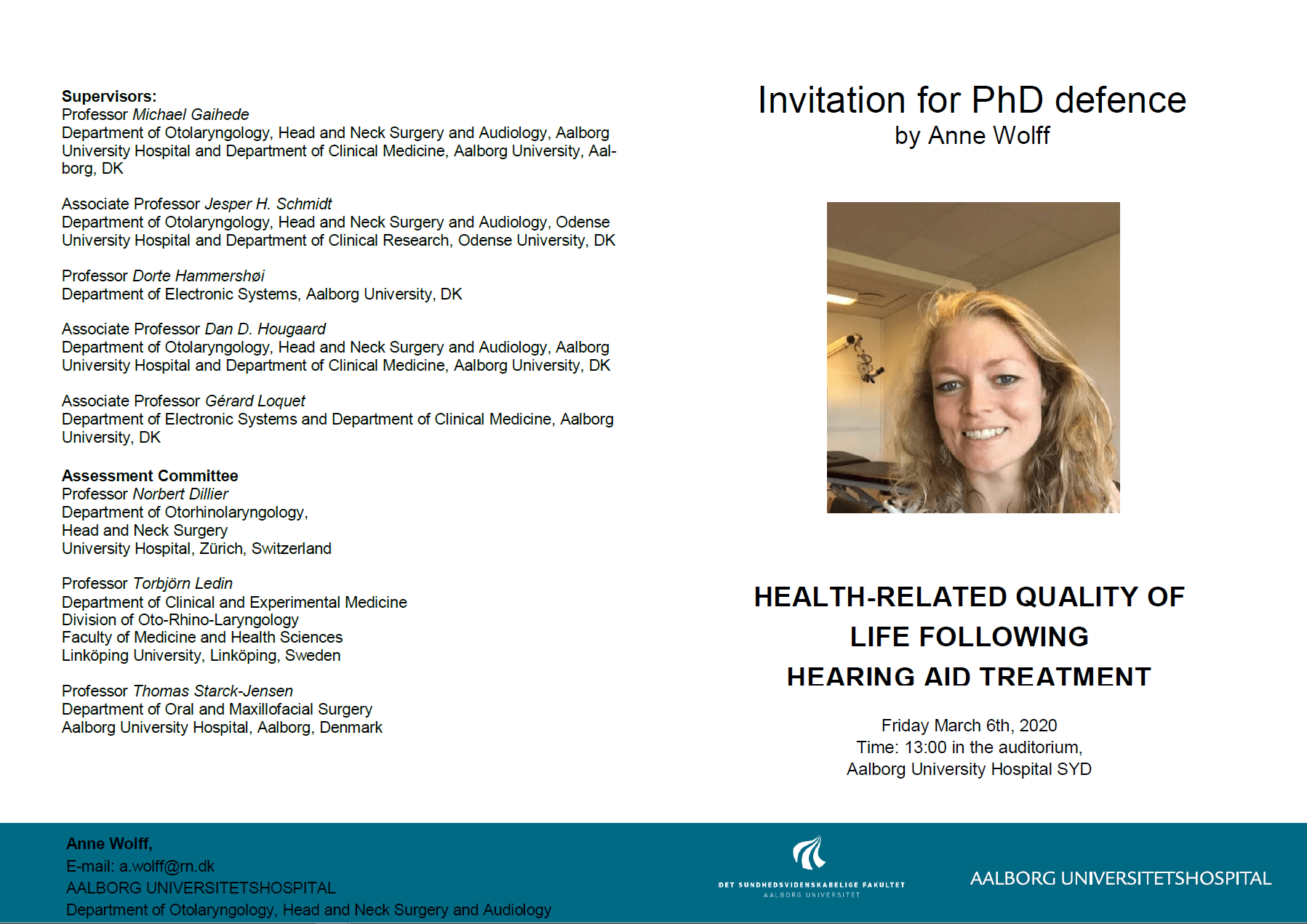
ENGLISH SUMMARY (from the PhD thesis by Anne Wolff):
More men than women have a hearing loss, and the incidence of hearing loss increases with age. In a study from 2010, the Knowledge Center for Hearing Disabilities estimated that 800,000 Danes have disabling hearing loss. The population projection from Statistics Denmark (2018) shows that the Danish population is expected to grow, primarily due to a growth of the oldest portion of the population. This will result in more people in need of treatment for hearing loss in the future. The hearing threshold is the clinical measure most often used to determine whether there is hearing loss and, if so, how severe. This is measured by tone audiometry which tests how intense a given tone must be presented before it can be heard by the patient. Hearing loss can also manifest in the form of difficulty understanding and distinguishing words from one another. This is typically measured by speech audiometry in which a number of words are played and must be repeated by the patient.
The most frequent treatment for hearing loss is the fitting of hearing aids. The majority of treated patients benefit from the use of hearing aids. A hearing aid works by receiving and amplifying sound before sending the amplified sound signal to the ear. Described as such it may seem simple, yet both hearing and sound processing are complex tasks, and there still remains conditions that make successful hearing aid treatment a challenge to obtain across the hearing impaired population. More knowledge about what characterises these patients, who face challenges, as well as knowledge on those who do not, may form the basis of improved treatment in the future.
This dissertation is based on three articles which are based on the first clinical part of the Better hEAring Rehabilitation project (BEAR). BEAR is a five-year project whose goal is to improve hearing aid treatment in Denmark based on clinical research, and if favourable, evidence-based renewal of clinical practice. In the first part of the BEAR project, a database containing information on almost 2,000 patients was established. Patients were included over the course of a year when examined and treated for hearing loss at the Department of Audiology at Odense and Aalborg University Hospitals. The database contains data from questionnaires and audiometric data, as well as data from an objective measurement of the amplified sound delivered to each patient via HAs.
Manuscript 1 reports on quality of life improvements for first-time and experienced hearing aid users after two months of hearing aid use. It was shown that experienced hearing aid users had lower hearing-related quality of life compared to new users before renewing/fitting new hearing aids. Both groups achieved improvement in their hearing-related quality of life after two months of treatment. The overall quality of life score increased for the group of first-time users, whereas no change was observed for the experienced users.
Manuscript 2 reports on quality of life and speech understanding in patients with asymmetrical hearing loss, that is, a difference in hearing between the right and left ear, compared to patients with symmetrical hearing loss. There is no common standard for defining asymmetrical hearing loss and we therefore used three different definitions: 1) more than 15 dB interlateral difference in pure-tone average (PTA) over four frequencies, 2) more than 15% interlateral difference in word recognition score (WRS) and 3) interlateral difference in audiogram configuration. It was shown that no matter the definition of asymmetrical hearing loss, patients had poorer hearing-related quality of life and spatial hearing before treatment compared to patients with symmetric hearing loss. Two months of hearing aid treatment improved both groups’ hearing-related quality of life and speech comprehension, regardless of asymmetry definition.
Manuscript 3 reports on a study of quality of life changes compared to how the hearing aid is fitted, according to the individual patient’s hearing loss. The hearing aid amplification in each patient was measured with real ear measurements and compared to a curve expected from a standard prescription, targeted to provide optimal speech understanding. The amplification provided by the hearing aids when a speech signal was played from a loudspeaker was measured and compared to the target curve projected by the standard prescription. It was shown that there was no correlation between self-reported quality of life, and self-reported hearing handicap in relation to the measured gain curve being on or not on reference.
Overall, it was found that hearing aid treatment significantly improved patients’ hearing-related quality of life. However, some subgroups of patients achieved less improvement than others. Among others, it was shown that patients with asymmetrical hearing had lower self-reported hearing-related quality of life and self-reported hearing handicap than patients with symmetrical hearing. These results will hopefully inspire further research in the field working towards improving health-related quality of life through improved hearing care and rehabilitation.

